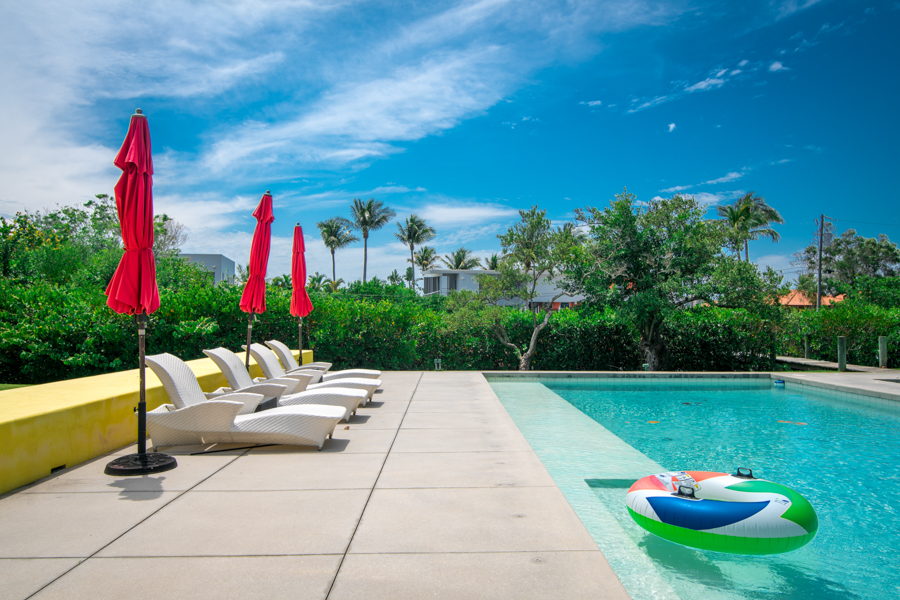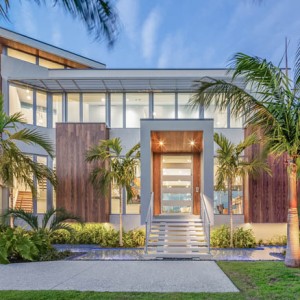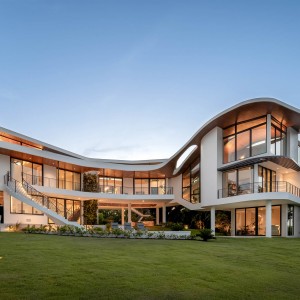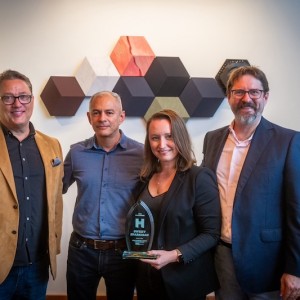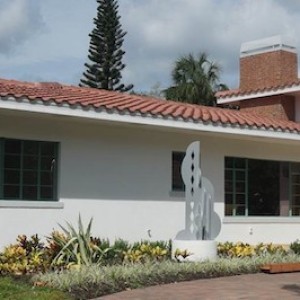Envision Sarasota in the 1950s: the economy rides high on the post-World War II boom, the wail of “Buy, Buy, Buy!” reaching a near deafening pitch; war veterans return home from the decimated shores of Europe with a winner’s grin, eager to throw off the heavy chains of combat along with the relics of the old world. Their parents’ clunky Victorian antiques get thrown out along with puff sleeves, setting the stage for a young population hell-bent on living minimally, swathed in free-flowing air, transparent design and clutter-free clean lines. Thus, the Modernism movement encompassed more than furniture and answered bigger questions than simply where to live; rather it signified how to live, ushering in a lifestyle for a whole new era.
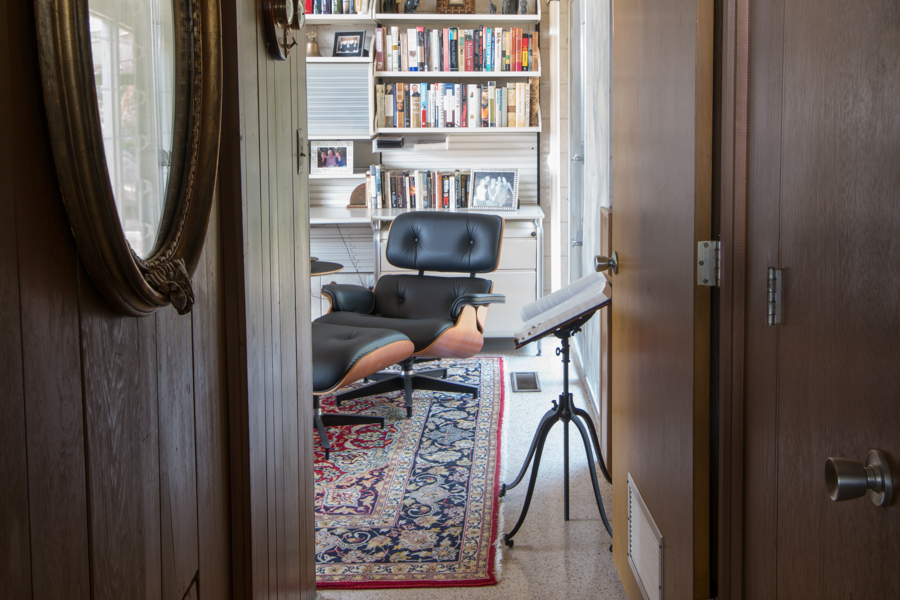
ELVGREN HOUSE (VICTOR LUNDY)
It’s this world that the Center for Architecture Sarasota attempted to recreate at the first-annual Modern Show, capturing the ‘50s spirit of post-war optimism and groundbreaking design. The year-old nonprofit positioned the event as a visceral experience rather than a typical fundraiser. “We knew we had to come up with something different—we didn’t want to do the same black tie dinner. We’re just a different kind of organization,” says CFAS Founder and Board Chair Cynthia Peterson. With that in mind, the Center asked architecture junkies and novices alike to immerse themselves in the Modernism experience for a weekend in May, first offering unguided tours of two homes—a Victor Lundy and a Paul Rudolph—whose designs capture the ethos of the movement. The Center’s historic headquarters on Orange Avenue was transformed into its original iteration, the Barkus Furniture Store, with a two-day sale of modern furniture and art. Among the designers: Mies van der Rohe, Charles and Ray Eames and Le Corbusier.
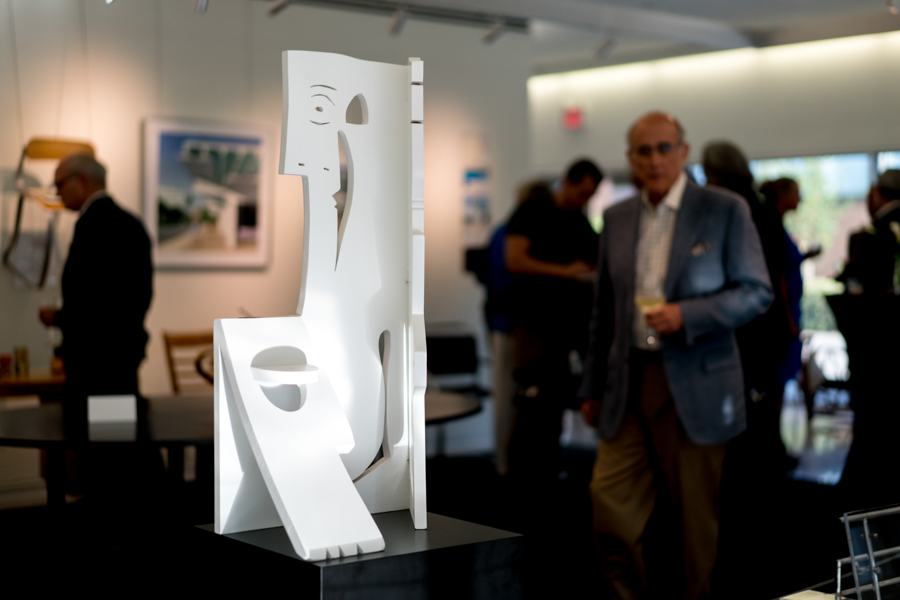
MAQUETTE (PAUL RUDOLPH)
Like the movement itself, the Modern Show broadened its focus to underscore the importance of the lifestyle as a whole with a vintage fashion show. Curated pieces from the era sailed down an outdoor runway as onlookers sipped mimosas. Free lectures spanned the second day as four architects and designers took the audience back in time to catch a glimpse of what Lundy or Rudolph could have been thinking when crafting their masterpieces.
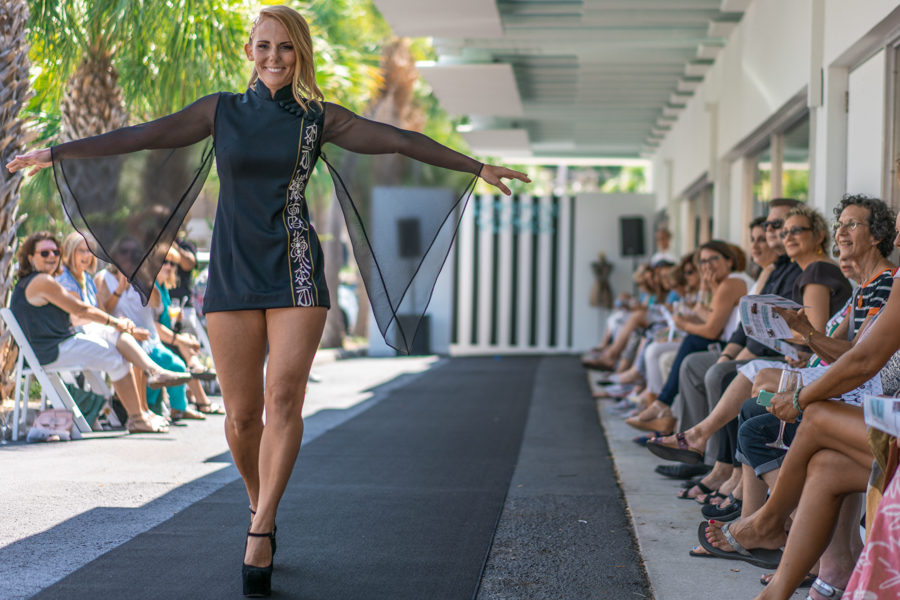
MODEL AT THE VINTAGE FASHION SHOW
“Having these lectures where they talk about these classic pieces and then [the audience] can walk outside and see them—most people don’t get the opportunity to see real pieces that they can really appreciate,” says Peterson. The Modern Show provided a portal into the world of 1950s America, and more importantly positioned Sarasota as a key hub of artistic revolution and design innovation.
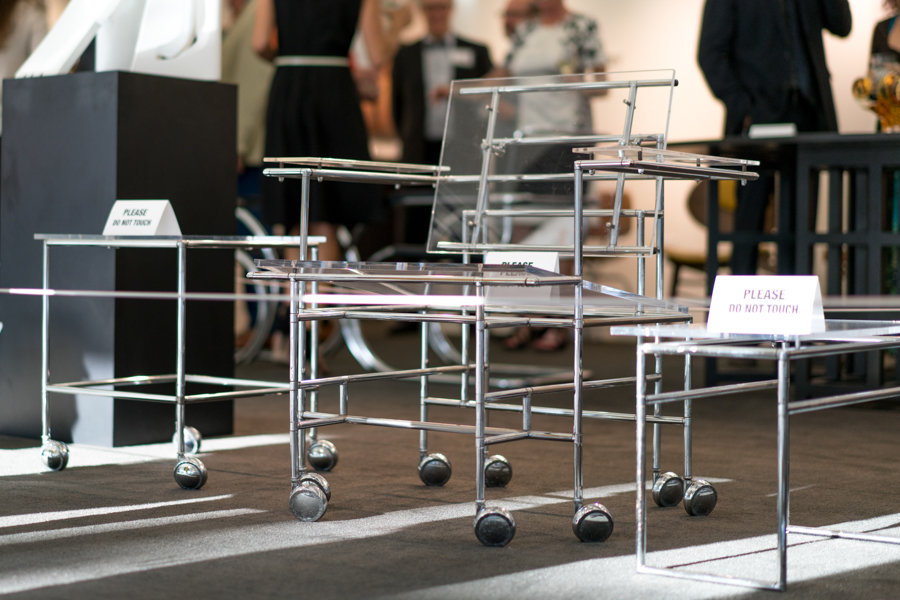
PLEXIGLASS CHAIR, STOOL AND TABLE (PAUL RUDOLPH)
------------------------------
Day 1, High Noon
The hired trolley jolts along Midnight Pass towards the forested southern tip of the Key, outside the party lines of tourists and Village hubbub. The driver takes a sharp left and suddenly the landscape changes—a long dirt road winds back to a cul-de-sac, the Elvgren House at the helm. A rambling cypress-wood home with a screened-in pool comes into view on the left and a sloped room perched atop 15-foot stilts to the right. Through the front door, the smell of long-broken-in wood mingles with wafts of humid air riding over the salty mangroves that border the back patio. Look up: grey-brown cypress beams spread out along the ceiling like the arms of a giant open umbrella. Glass panels line the top of the walls allowing shafts of afternoon light to filter through the kitchen and flow over the long dining table and out to the screened Florida room.
Designed by Victor Lundy in 1957, the home was built for the great American pin-up artist Gil Elvgren and has since rarely been seen by the public, the integrity of the Lundy design still intact (terrazzo flooring, steel railings and angular beams are all original). Just one of the creatives that flocked to the area during the time—see artist Ben Stahl and Pulitzer Prize-winning author MacKinlay Kantor—Elvgren and his counterparts “created a real cool, hip artist community kind of atmosphere,” says Peterson. The vibe permeates Lundy’s design for the house; transparent walls encircle the two almost blindingly bright bedrooms, giving the dwellers an unadulterated view of the rolling green yard, the long, Gatsby-esque dock and the glimmering water beyond. They were living in paradise—why shut it out?
A 25-foot undulated wooden beam cuts through the coquina-rock backdrop that dominates the wide living room. “It’s the center of a California Redwood tree,” says Drake Elvgren, Gil Elvgren’s son. “It took 24 men to lift and install it.” The last few feet of wood poke through the glass wall leading out to the open-air Florida room, drawing the eye across the edge of the house over the four 10-foot panes of floor-to-ceiling glass that make up a see-through wall of sorts. When slid open, 40 feet of outside air gushes freely into and throughout the house, slipping into every nook and cranny of the structure. The house is alive with air and light, without any true walls to confine it—“To me, it’s just home,” says Elvgren.
------------------------------
Day 1, Winding Down Late Afternoon
Back on the trolley, riders bump and jostle and jerk to the opposite end of Siesta Key, before making the turn-off to beaches and beer, where private enclaves and winding canals abound. A trio of palatial royal palms swells upward toward the blinding sun, acting as wardens to a habitat no longer of this world. The house is entirely transparent—look through the top-to-bottom glass front “wall” and you’ll catch a glimpse of the shimmering pool and stark white slab deck in the back. Pass through the front sitting room shrouded in greenery and left en plein air. Make your way through to the living room, where a massive copper flume rises out of a curved brick fireplace. Notice that the low-hanging ceiling is painted, in Rudolph’s words, “strong peacock blue,” to an oceanic effect on the terrazzo tile floor—all indoor vision is tinted undersea blue. The flume breaks through to the other side of the wall, sitting snugly above the ‘50s-era stove and original “rust red” countertops. Bedrooms feature entire walls of the original built-ins complete with their thick leather pulls.
In 1948, the construction of the 900-square-foot Revere Quality House marked a partnership between Ralph Twitchell, his young associate Paul Rudolph and the Revere Copper and Brass Company; its design elements came to define the pervading style of Florida in the ‘50s and the early character of the Sarasota School of Architecture. Refurbished in 2007 by architect (and husband of CFAS’ Cynthia Peterson) Guy Peterson, much of the interior design was restored with the help of Rudolph’s sketches, and many of the original elements remain. The only striking difference is the shadow cast by the immense 4,400-square-foot modern structure on the left side of the property, built by Guy for the land’s new owner. Cynthia muses that the towering new Rudolph-style home “is one of the best examples of how we can repurpose one of those Mid-century buildings especially when they are on beautiful pieces of property and are threatened.”
A lonely inner tube floats idly across the pool’s surface, and although notes of Trey Songz “Say Aah” trickle over the bayou from a neighboring house, you only need close your eyes to fall into the rapture of the life presented here. See an Audrey Hepburn-haired woman in a wide-brimmed hat, sunning herself on one of the crisp white loungers, a vodka martini with a skewered olive in one hand and a filtered Lucky Strike in the other, her husband sporting a fresh military buzz diving into the long crystalline lap pool.
------------------------------
Day 2, Home Base
The once minimal gallery space inside the CFAS building has morphed into a furniture playground, with people old and young knocking at the doors as early as 8am. “Do Not Sit” signs reign supreme, keeping everyone in check. While the for-sale items are the hot ticket of the day, the pièce de résistance sits shining and unattainable in the front of the hall, roped off and watched over by security-guard eyes: a Plexiglass chair, stool and end table, a tubular hanging light and a bizarro-world white sculpture resembling a face—all creations that originated deep within the annals of Paul Rudolph’s brain. The never-before-seen pieces were scooped straight out of Rudolph’s mysterious Beekman Place apartment in New York City, the funky white mini-sculpture (or maquette) Rudolph’s replica of a never-constructed sculpture made by his friend Pablo Picasso.
Take a walk outside—the left-hand shaded corridor of the CFAS building now houses a black carpet runway with white folding chairs. Women in cat-eye sunglasses and canary yellow dresses sip canary yellow mimosas. Men with slicked hair and tropical shirts laugh and keep the champagne flowing. Influence Vintage owner Rachel Matthes takes the mic: “All vintage was modern at one time,” she says. “Each piece tells a story. It is so rich in nostalgia, just like the Modern Show.”
Starry-eyed women pour down the runway, flecks of gold dripping down their hair, dressed in sheer smoking dresses, electric blue turbans and tan bowed driving gloves, twirling red umbrellas and channeling the gingham checks and ruffled collars of ‘50s housewives. One model tiptoed down the runway in impossibly high wedges, clad in an Alfred Shaheen black mini dress, raising her arms to show off the sheer winged sleeves of the delicate garment. Reaching the end of the runway, another kicks us back to the present as she takes an iPhone out of her tiny black satin purse and snaps a selfie.
------------------------------
Ready to come back down to 2016? CFAS Board Member and Marketing Chair Sandra Timpson-Motto will tell you that in Sarasota, even after the show packs up, the movement that defined the ‘50s always surrounds us. “This design is everywhere we look, it’s organic,” she says. The show still in full swing, patrons asked CFAS members the date for next year. “I think we’ve opened up the community to a different view of what the built environment offers,” says Peterson. “We’ve shown them how important it is to protect it, talk about it and take ownership of it.”
------------------------------
A Tête-à-Tête with Richard Geary
As one of the only people to see and photograph Paul Rudolph’s infamous New York Beekman Place apartment before its multiple remodels, Richard Geary brings an insider’s eye to Rudolph scholarship. SRQ sat down with him in the midst of preparing for his keynote speech at the Modern Show.
SRQ: When did you become interested in Rudolph’s 23 Beekman Place apartment and how did you get access to it? Geary: In 1999 there was an article in Nest magazine where I saw pictures of the apartment. Paul had died and the apartment was going to go away. So I made a cold call to the editor and I said, “Is there any possible way that you could give me the contact information of somebody so I could go in and look at this before it’s gone?” He gave me Ernst Wagner’s name who was Paul’s partner and was living there at the time. So I called Ernst up and I went and took a tour through the place. I came a few weeks later with a photographer and we shot 50 rolls of film in three days—Ernst just handed me the keys.
What was your experience of first walking into the apartment? It’s a very disconcerting space. It’s complicated and it’s fascinating. It has four stories that are virtually transparent vertically. We live in spaces that are relatively easy to understand. Then you begin to blur those lines and you begin to go up stairs that have no handrails and are just a series of horizontal planes that go up the side of a wall. And next to them are three-inch thick Plexiglass floors that make the hallways that you can see through for three stories.
How does the furniture taken from the apartment and showcased here at the Modern Show speak to the rest of the apartment? It was more about the language of the space than it had to do with any of the furniture. It was really just those couple of chairs and the fact they were built out of this kind of display system. He adapted this system along with the Plexiglass seats and backs to make almost invisible pieces of furniture that could be moved around—nothing ever distracted from the architecture of the space.
How does the Beekman Place apartment play into Rudolph’s greater architectural oeuvre? For Paul Rudolph this is about as personal as it ever could get. This was his opus. It was continually evolving as he evolved but it was a very personal statement. It was a thrilling space. Thrilling and terrifying. He created this kind of oasis of his own making.





